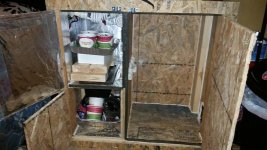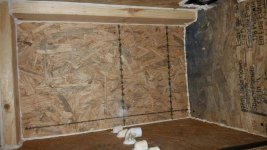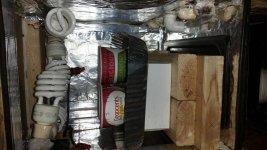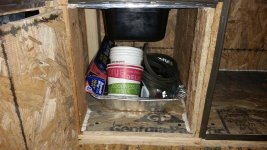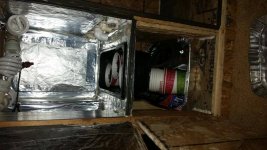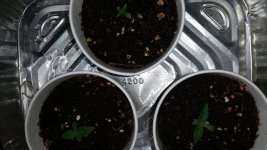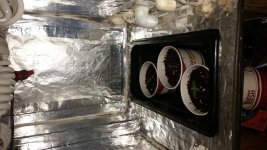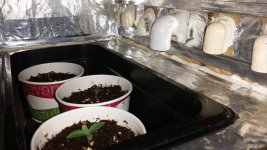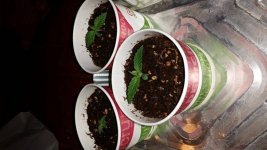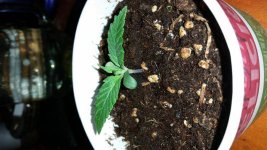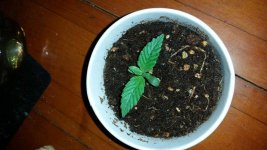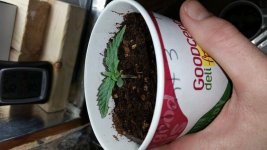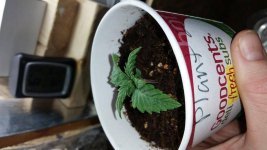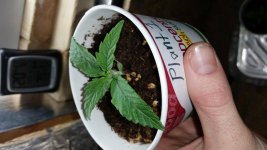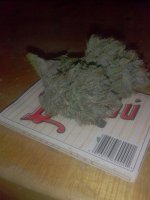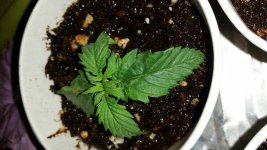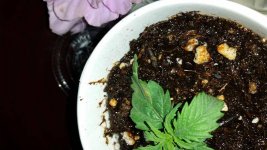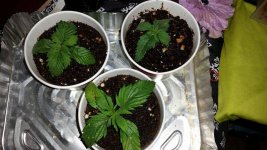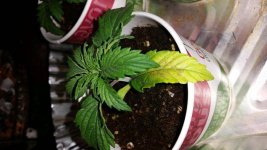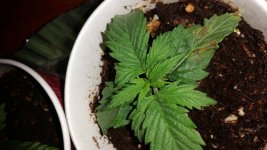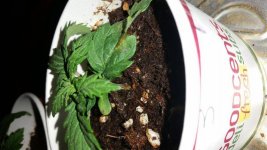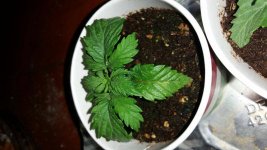...my first choice is always the elastomeric white paint.
bozo
Foylon:
A more durable version of mylar, made of spun polyester fabric and reinforced with foil laminate. Foylon is resistant to most solutions, won't tear or fade, and can be wiped or washed clean.
A great solution for growers who are interested in long term use, and though it may be slightly more expensive than mylar, its durability will more than make up for its cost. It has the ability to reflect about 95% of the light and approximately 85% of the heat energy, so a good ventilation system should be used in conjunction with folyon.
A recommended method to attach Foylon to the walls would be using Velcro, as it makes taking it down for cleaning much easier nd reduces the risk of tearing, creasing or bending it. If this is used for your walls, making sure you get it flush with the wall with no pockets of air between it and the wall to prevent hotspots.
Mylar:
A highly reflective polyester film that comes in varying thickness, the most common being 1 and 2 mm thick. The 2mm thick mylar while not quite as durable as the foylon, is fairly rugged. The 1mm thick mylar tears fairly easily, so taking it down for cleaning is quite difficult without damaging it in the process. Both types of mylar are able to reflect approximately 92-97% reflective, giving it the potential to be more reflective than foylon, but because foylon is more easily cleaned without damaging it as well as it being harder to crease, foylon usually ends up being slightly more reflective. Important to note is that mylar reflects radiant heat energy just as well as foylon (around 85%), so proper ventilation is necessary if mylar is used in your grow room. Attaching this to walls can be done in a similar fashion as foylon, and the same caution should be used to avoid creating hotspots in your room. The 1mm thick mylar stands a fair chance of being creased or ripped in the process unfortunately, even if Velcro is used to attach to the walls.
C3 anti-detection film:
A specialized type of mylar that exhibits the same properties as the 2mm thick mylar, but in addition to reflecting approximately 92-97% of the light, it also is 90% infrared proof, making your grow room all but invisible to IR scanning. This can also be attached in the same manner as foylon or mylar, and the same caution should be used to avoid creating hotspots in your room.
Flat white paint:
Self explanatory; a great option for large grow rooms or for people who are interested in a low maintenance wall. Flat white paint has the ability to reflect between 75-85% of the light, and does not create hotspots. Adding a fungicide is recommended when painting.
Glossy and eggshell whites not reflect light as efficiently as flat white. Semi-gloss paint for example, only has the ability to reflect between 55-60% of the light. Also important to remember when using paint is that any smears or blemishes on the surface take away from how reflective the wall is so care should be taken to avoid marking or staining the walls. Titanium white paint is very reflective; however it is usually only used on reflectors due to its high cost.
Elastomeric paint (info by furun)
A rubberized roofing paint with 90% reflection. Good for growboxes. Mildew resistant. Highly reflective.
Kool Seal White Elastomeric Roof Coating ~ $15.00 (1 Gallon)
Ultra high reflectivity
Forms a rubber-like blanket that expands and contracts
Adheres to almost any surface (very good on wood and metal)
Available @ Lowe's Home Improvement: Buy Kitchen Cabinets, Paint, Appliances & Flooring
White/Black plastic (also known as panda plastic or "poly"):
"Poly" is useful if you are setting up a temporary grow room or don’t want to damage the walls. Poly is easily cleaned.
The purpose of the black side is to not allow any light to pass through the plastic, which ensures your dark cycle remains dark. The white side is 75-90% reflective. Choose a 6 "mill" thickness of poly for maximum light blockage and duribility.
If this plastic is put too close to the light, you will obviously melt it so be careful!. Panda plastic does not create hotspots. Poly can be attached to the walls by using carpenter’s nails or using tape glue or similar means. This can be used as a cheap alternative to mylar if painting your grow room is out of the question.
Polystyrene Foam Sheeting (more commonly known as Styrofoam):
This is excellent for harsh environment growrooms (your attic for example), provided you have a good ventilation system and a way to keep the temperatures from rising too high (an a/c unit or similar) as it is an excellent insulator.
It is also a great material for use in a temporary setup or for use as a "travelling reflector" on a light mover, where weight is a concern. It is approximately 75-85% light reflective so it is comparable to using a flat white paint. Foam will not create hot spots. Rigid foam can be purchased in sheets, and can be used as a free standing wall or can be taped, glued or nailed to the wall, the last generally being the most successful method.
Emergency Blankets:
These are ultra thin polyester blankets that are sold in most camping stores and are constructed of a single layer of polyester film that is covered with a layer of vapor deposited aluminum.
It is not very effective at reflecting light because it is so thin. Holding it between you and a light source, many small holes are noticed at the intersections of creases and the entire blanket is translucent to begin with, this coupled with the many creases that are in it when you purchase it takes away a significant amount of it reflectivity. It is very easily creased as well which also detracts from its ability to reflect light. And while it is reflects nearly 90% of radiant heat energy, it is only able to reflect around 70% of the light.
The largest advantage of using this type of material is that it is very cheap and therefore easily replaced. Emergency blankets can create hotspots if not attached flush to the wall so it is important that no air gaps exist between it and your supporting wall. The easiest way to attach this is to use tape (Aluminum or metal tape is recommended), as it tears very easily once it is cut or punctured.
Aluminum Foil:
Aluminum foil is no more than 55% reflective - if used, make sure that the dull side is the one that is used to reflect the light. When it becomes creased its reflectivity is even lower (around 35%.) It is also very dangerous to use because it creates hotspots easily, is electrically conductive, and is a fire hazard when it is in close contact with HID lighting. Attaching this to walls is a pain and usually using aluminum tape or glue is the best way. This should only be used as a last resort, and even then its usefulness is questionable.
bozo
Foylon:
A more durable version of mylar, made of spun polyester fabric and reinforced with foil laminate. Foylon is resistant to most solutions, won't tear or fade, and can be wiped or washed clean.
A great solution for growers who are interested in long term use, and though it may be slightly more expensive than mylar, its durability will more than make up for its cost. It has the ability to reflect about 95% of the light and approximately 85% of the heat energy, so a good ventilation system should be used in conjunction with folyon.
A recommended method to attach Foylon to the walls would be using Velcro, as it makes taking it down for cleaning much easier nd reduces the risk of tearing, creasing or bending it. If this is used for your walls, making sure you get it flush with the wall with no pockets of air between it and the wall to prevent hotspots.
Mylar:
A highly reflective polyester film that comes in varying thickness, the most common being 1 and 2 mm thick. The 2mm thick mylar while not quite as durable as the foylon, is fairly rugged. The 1mm thick mylar tears fairly easily, so taking it down for cleaning is quite difficult without damaging it in the process. Both types of mylar are able to reflect approximately 92-97% reflective, giving it the potential to be more reflective than foylon, but because foylon is more easily cleaned without damaging it as well as it being harder to crease, foylon usually ends up being slightly more reflective. Important to note is that mylar reflects radiant heat energy just as well as foylon (around 85%), so proper ventilation is necessary if mylar is used in your grow room. Attaching this to walls can be done in a similar fashion as foylon, and the same caution should be used to avoid creating hotspots in your room. The 1mm thick mylar stands a fair chance of being creased or ripped in the process unfortunately, even if Velcro is used to attach to the walls.
C3 anti-detection film:
A specialized type of mylar that exhibits the same properties as the 2mm thick mylar, but in addition to reflecting approximately 92-97% of the light, it also is 90% infrared proof, making your grow room all but invisible to IR scanning. This can also be attached in the same manner as foylon or mylar, and the same caution should be used to avoid creating hotspots in your room.
Flat white paint:
Self explanatory; a great option for large grow rooms or for people who are interested in a low maintenance wall. Flat white paint has the ability to reflect between 75-85% of the light, and does not create hotspots. Adding a fungicide is recommended when painting.
Glossy and eggshell whites not reflect light as efficiently as flat white. Semi-gloss paint for example, only has the ability to reflect between 55-60% of the light. Also important to remember when using paint is that any smears or blemishes on the surface take away from how reflective the wall is so care should be taken to avoid marking or staining the walls. Titanium white paint is very reflective; however it is usually only used on reflectors due to its high cost.
Elastomeric paint (info by furun)
A rubberized roofing paint with 90% reflection. Good for growboxes. Mildew resistant. Highly reflective.
Kool Seal White Elastomeric Roof Coating ~ $15.00 (1 Gallon)
Ultra high reflectivity
Forms a rubber-like blanket that expands and contracts
Adheres to almost any surface (very good on wood and metal)
Available @ Lowe's Home Improvement: Buy Kitchen Cabinets, Paint, Appliances & Flooring
White/Black plastic (also known as panda plastic or "poly"):
"Poly" is useful if you are setting up a temporary grow room or don’t want to damage the walls. Poly is easily cleaned.
The purpose of the black side is to not allow any light to pass through the plastic, which ensures your dark cycle remains dark. The white side is 75-90% reflective. Choose a 6 "mill" thickness of poly for maximum light blockage and duribility.
If this plastic is put too close to the light, you will obviously melt it so be careful!. Panda plastic does not create hotspots. Poly can be attached to the walls by using carpenter’s nails or using tape glue or similar means. This can be used as a cheap alternative to mylar if painting your grow room is out of the question.
Polystyrene Foam Sheeting (more commonly known as Styrofoam):
This is excellent for harsh environment growrooms (your attic for example), provided you have a good ventilation system and a way to keep the temperatures from rising too high (an a/c unit or similar) as it is an excellent insulator.
It is also a great material for use in a temporary setup or for use as a "travelling reflector" on a light mover, where weight is a concern. It is approximately 75-85% light reflective so it is comparable to using a flat white paint. Foam will not create hot spots. Rigid foam can be purchased in sheets, and can be used as a free standing wall or can be taped, glued or nailed to the wall, the last generally being the most successful method.
Emergency Blankets:
These are ultra thin polyester blankets that are sold in most camping stores and are constructed of a single layer of polyester film that is covered with a layer of vapor deposited aluminum.
It is not very effective at reflecting light because it is so thin. Holding it between you and a light source, many small holes are noticed at the intersections of creases and the entire blanket is translucent to begin with, this coupled with the many creases that are in it when you purchase it takes away a significant amount of it reflectivity. It is very easily creased as well which also detracts from its ability to reflect light. And while it is reflects nearly 90% of radiant heat energy, it is only able to reflect around 70% of the light.
The largest advantage of using this type of material is that it is very cheap and therefore easily replaced. Emergency blankets can create hotspots if not attached flush to the wall so it is important that no air gaps exist between it and your supporting wall. The easiest way to attach this is to use tape (Aluminum or metal tape is recommended), as it tears very easily once it is cut or punctured.
Aluminum Foil:
Aluminum foil is no more than 55% reflective - if used, make sure that the dull side is the one that is used to reflect the light. When it becomes creased its reflectivity is even lower (around 35%.) It is also very dangerous to use because it creates hotspots easily, is electrically conductive, and is a fire hazard when it is in close contact with HID lighting. Attaching this to walls is a pain and usually using aluminum tape or glue is the best way. This should only be used as a last resort, and even then its usefulness is questionable.

